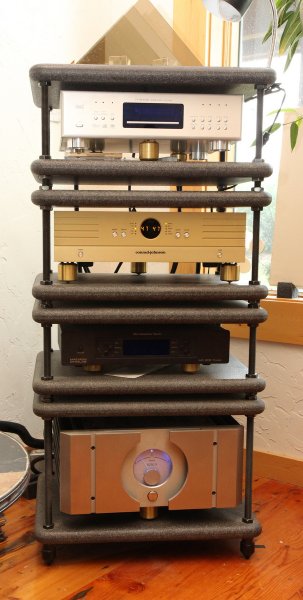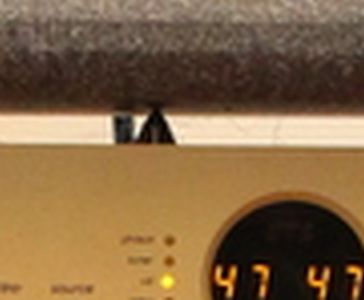I would like to thank member Stehno for posting some very interesting comments about vibration management that have me rethinking my approach to and understanding of this fascinating topic. Here is what he posted in the Introspection and hyperbole control thread in a discussion about an amplifier stand. As I understand it, all components suffer from vibrations which adversely effect sound quality. As I understand it, Stehno believes that these vibrations need a path on which to travel away from the component. Isolation breaks this path and traps the vibrations within the component where they wreak their havoc. I think this topic deserves its own thread and might prove very interesting with regards to the several threads about active and passive isolation devices.
Quote Originally Posted by PeterA View Post
Stehno, you write some interesting stuff. Could you be a bit more explicit about proper vibration and AC management?
Thanks, Peter. My primary reason for responding was 1) you asked some very basic and sound questions that deserved sufficient answers that as Microstrip alluded, and I'm confident nobody else could sufficiently respond. And 2) because Microstrip clearly said, nobody had a clue. Though it seems he's now backing away from that claim. And I suppose I wanted to offer a hopefully straight-forward response before some "expert" stepped in to describe what a tremendously difficult scientific feat it is for them to "isolate" vibrations in our vibration-rich universe.
Quote Originally Posted by PeterA View Post
To what products or designers do you refer?
I'm not sure I referred to any specific product or designer but if any such manufacturer or enthusiast ever uses the word "isolation" in a positive sense I suppose I'm referring to potentially everybody.
Quote Originally Posted by PeterA View Post
I think I recall you describing your rack and the importance of mechanical clamping in its design. I assume you prefer a combination of energy drainage away from the component and isolation of external sources of vibrations. The two in combination should be effective.
Yes, no, and no.
Yes. Although the rack design is of paramount importance, surely many of us are aware of those who mass load their components with some form of weight placed on top usually in the 25 lbs. to 50 lbs. range and then swearing by their performance benefits. Years ago I did some experimenting over about a 6 month period of time and made a few interesting discoveries along the way. As a result and in contrast to the lightweight freestanding mass loading methods others use, I currently invoke an extreme form of clamping on my components where I’ve roughly 1000 lbs. of compressive force on my mono-block amps sandwiching them to the shelf, over 650 lbs. on the CDP, and well over 300 lbs. on my small passive line conditioners. I would add that every one of those pounds count toward performance. But as important as that is, there’s more to it than just extreme mass loading.
No. As I said earlier, I never use the word isolation in a positive sense but only in the negative and for several reasons. 1) I see no reason why I should spend any of my time working against basic laws of nature trying to achieve the impossible even though some other really smart fellers will go to their graves trying to achieve what is not possible and ta take others’ money in the process. 2) Since there are multiple sources of vibrations that potentially induce sonic harm, apparently nobody else but Microstrip and I are the only ones who understand that if I should isolate our sensitive components from a single vibration source (which is possible), inherently and immediately I’ve just trapped all vibrations that enter the component from other sources. That’s like one step forward and at least one step backward and when dealing with such fundamentals, there’s absolutely no reason for any such compromise.
Besides, as I mentioned earlier, resonant energy seeks first and foremost to travel. That’s a big fundamental so my goal is to do what I can to allow that to happen and I go to tremendous extremes to perform due diligence there.
No. As I shared earlier, although “isolation” based products can leak out some performance benefits provided the design strays from the isolation method. But isolation is nothing more than a grotesquely inferior form of superior vibration management and hence has no place in my executions. Strategic damping, yes. Isolation, no. See above.
Quote Originally Posted by PeterA View Post
Could you copy or move some of your posts in this Introspection and hyperbole thread to a new thread dedicated to addressing the challenges of vibrational energy?
I've no problem discussing at least to some extent what I think constitutes superior forms of vibration management so if you wanna open a new thread I'd be happy to participate.
Quote Originally Posted by PeterA View Post
Stehno, you write some interesting stuff. Could you be a bit more explicit about proper vibration and AC management?
Thanks, Peter. My primary reason for responding was 1) you asked some very basic and sound questions that deserved sufficient answers that as Microstrip alluded, and I'm confident nobody else could sufficiently respond. And 2) because Microstrip clearly said, nobody had a clue. Though it seems he's now backing away from that claim. And I suppose I wanted to offer a hopefully straight-forward response before some "expert" stepped in to describe what a tremendously difficult scientific feat it is for them to "isolate" vibrations in our vibration-rich universe.
Quote Originally Posted by PeterA View Post
To what products or designers do you refer?
I'm not sure I referred to any specific product or designer but if any such manufacturer or enthusiast ever uses the word "isolation" in a positive sense I suppose I'm referring to potentially everybody.
Quote Originally Posted by PeterA View Post
I think I recall you describing your rack and the importance of mechanical clamping in its design. I assume you prefer a combination of energy drainage away from the component and isolation of external sources of vibrations. The two in combination should be effective.
Yes, no, and no.
Yes. Although the rack design is of paramount importance, surely many of us are aware of those who mass load their components with some form of weight placed on top usually in the 25 lbs. to 50 lbs. range and then swearing by their performance benefits. Years ago I did some experimenting over about a 6 month period of time and made a few interesting discoveries along the way. As a result and in contrast to the lightweight freestanding mass loading methods others use, I currently invoke an extreme form of clamping on my components where I’ve roughly 1000 lbs. of compressive force on my mono-block amps sandwiching them to the shelf, over 650 lbs. on the CDP, and well over 300 lbs. on my small passive line conditioners. I would add that every one of those pounds count toward performance. But as important as that is, there’s more to it than just extreme mass loading.
No. As I said earlier, I never use the word isolation in a positive sense but only in the negative and for several reasons. 1) I see no reason why I should spend any of my time working against basic laws of nature trying to achieve the impossible even though some other really smart fellers will go to their graves trying to achieve what is not possible and ta take others’ money in the process. 2) Since there are multiple sources of vibrations that potentially induce sonic harm, apparently nobody else but Microstrip and I are the only ones who understand that if I should isolate our sensitive components from a single vibration source (which is possible), inherently and immediately I’ve just trapped all vibrations that enter the component from other sources. That’s like one step forward and at least one step backward and when dealing with such fundamentals, there’s absolutely no reason for any such compromise.
Besides, as I mentioned earlier, resonant energy seeks first and foremost to travel. That’s a big fundamental so my goal is to do what I can to allow that to happen and I go to tremendous extremes to perform due diligence there.
No. As I shared earlier, although “isolation” based products can leak out some performance benefits provided the design strays from the isolation method. But isolation is nothing more than a grotesquely inferior form of superior vibration management and hence has no place in my executions. Strategic damping, yes. Isolation, no. See above.
Quote Originally Posted by PeterA View Post
Could you copy or move some of your posts in this Introspection and hyperbole thread to a new thread dedicated to addressing the challenges of vibrational energy?
I've no problem discussing at least to some extent what I think constitutes superior forms of vibration management so if you wanna open a new thread I'd be happy to participate.




